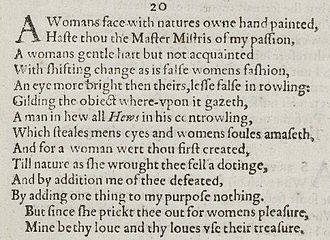Sonnet 20
Q1
Q2
Q3
C
A woman’s face with Nature’s own hand painted
Hast thou, the master-mistress of my passion;
A woman’s gentle heart, but not acquainted
With shifting change, as is false women’s fashion;
An eye more bright than theirs, less false in rolling,
Gilding the object whereupon it gazeth;
A man in hue, all “hues” in his controlling,
Which steals men’s eyes and women’s souls amazeth.
And for a woman wert thou first created;
Till Nature, as she wrought thee, fell a-doting,
And by addition me of thee defeated,
By adding one thing to my purpose nothing.
But since she prick’d thee out for women’s pleasure,
Mine be thy love and thy love’s use their treasure.
4
8
12
14
Sonnet 20 is one of the best-known of 154 sonnets written by the English playwright and poet William Shakespeare. Part of the Fair Youth sequence (which comprises sonnets 1-126), the subject of the sonnet is widely interpreted as being male, thereby raising questions about the sexuality of its author. In this sonnet (as in, for example, Sonnet 53) the beloved's beauty is compared to both a man's and a woman's.
Sonnet 20 is a typical English or Shakespearean sonnet, containing three quatrains and a couplet for a total of fourteen lines. It follows the rhyme scheme of this type of sonnet, abab cdcd efef gg. It employs iambic pentameter, a type of poetic metre based on five pairs of metrically weak/strong syllabic positions. "Only this sonnet about gender has feminine rhymes throughout."
The first line exemplifies regular iambic pentameter with a final extrametrical syllable or feminine ending:
Sonnet 20 is most often considered to be a member of the "Fair Youth" group of sonnets, in which most scholars agree that the poet addresses a young man. This interpretation contributes to common assumption of the homosexuality of Shakespeare, or at least the speaker of his sonnet. The position of Sonnet 20 also influences its analysis and examinations. William Nelles, of the University of Massachusetts, Dartmouth, claims that, "Sonnet 20 splits readers into two groups: those who see an end to any clear sequence after this point, and those who read on, finding a narrative line connecting the rest of the sonnets in a meaningful pattern." Scholars have suggested countless motivations or means of organizing Shakespeare's sonnets in a specific sequence or system of grouping. Some see the division between the sonnets written to the "young man", while others do not. A number of academics believe the sonnets may be woven into some form of complex narrative, while "Paul Edmondson and Stanley Wells confidently assert that the sonnets are 'better thought of as a collection than a sequence, since…the individual poems do not hang together from beginning to end as a single unity…Though some of the first 126 poems in the collection unquestionably relate to a young man, others could relate to either a male or female.'"
...
Wikipedia

